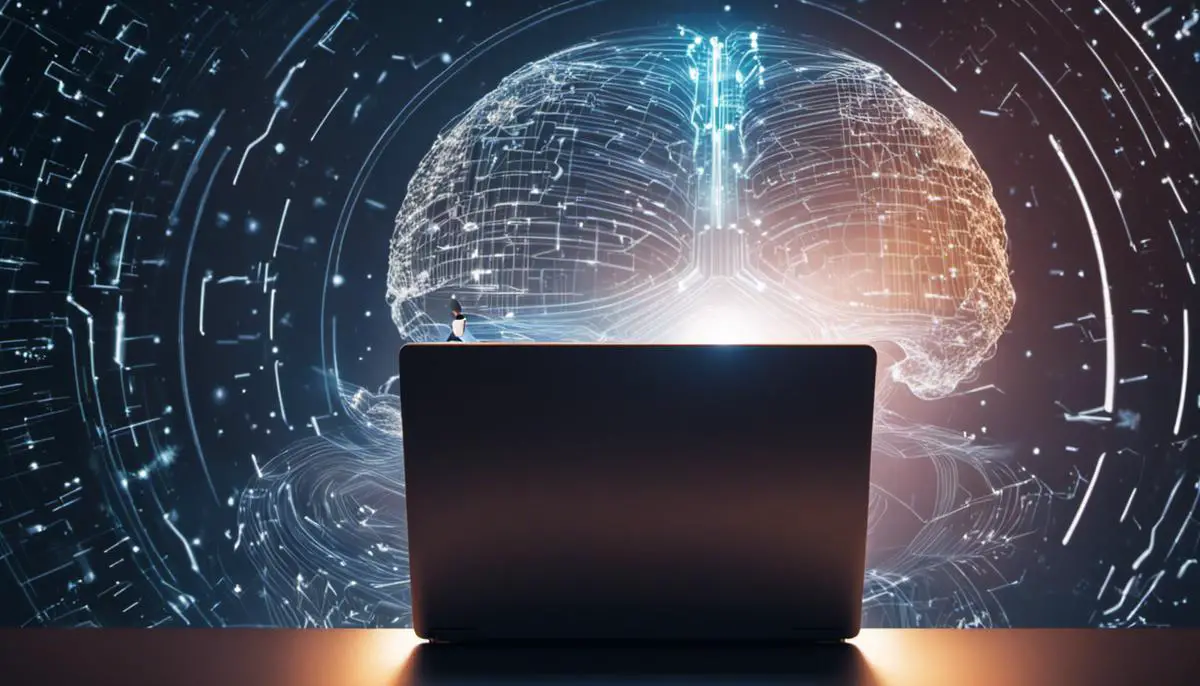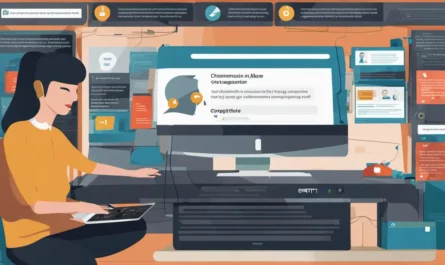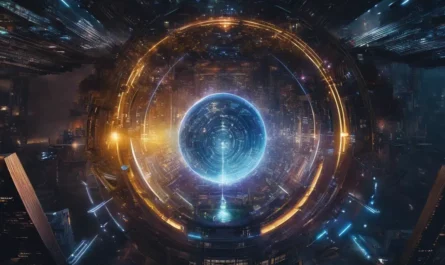The advent of Artificial Intelligence, popularly known as AI, continues to revolutionize numerous aspects of our lives and professions. Among them, content creation has seen a tremendous transformation on integrating AI, with an incredible change in how content is created, curated, and optimized. From a broader viewpoint, AI serves as a potent tool that automates and personalizes the content, but the full scope of its function is intricate and vast. This discourse aims to take you on a journey of understanding AI, exploring its various applications in content creation, assessing its benefits, and pondering over the potential challenges that come along with it. As we unravel this subject, we also keep an eye toward the future, anticipating the advances AI might bring to content creation.
Understanding AI and Its Role in Content Creation
‘AI and Its Revolutionary Role in Content Creation’
Hello fellow creators, tech enthusiasts, and curious minds! Welcome onboard this hypothetical journey through the heart of Artificial Intelligence (AI), and its transformative influence on content creation.
Let’s take off by understanding: “What is AI?” It is fascinating yet complex. AI, in essence, is a segment of computer science that imitates, develops, and expands human intelligence in machines. These machines programmed with AI can learn from experiences, adapt to new prompts, and perform human-like tasks. But how can this machine learning wizardry, ubiquitously referred to as AI, shape content creation? Buckle up; we’re in for an exciting ride!
Much like ingredients and recipes to a chef, data is the key ingredient for AI. The AI model learns through exposure to huge amounts of data, enabling it to draw inferences, predictions, and produce remarkably human-like content. Hence, AI is leveraged to innovate and transform the way content is created and delivered.
One might ask, ‘Does AI replace human creators?’ It’s important to comprehend that AI is not here to replace but to assist and redefine the creation process. It stands as a compelling tool, enhancing human creativity rather than diminishing it.
AI has starred in multiple arenas of content creation, quite notably in writing, video, and music production. It utilizes natural language processing and generation (NLP/NLG) to craft SEO-friendly copy, website content, emails, or social media posts. AI simplifies monotonous tasks, enabling creators to maximize their focus on ideating and strategizing.
Machine learning algorithms have been powering video content platforms like TikTok and YouTube. They curate and recommend content tailored to each viewer’s preference, increasing engagement and viewership rates. Not to mention AI’s prowess in video editing, enhancing efficiency, and reducing the time taken to produce professional-quality videos.
The music industry isn’t left behind; AI has been making significant waves here too. From creating intriguing background scores for video games to composing entire songs, AI is hitting the right notes!
The introduction of AI in content creation has indeed charted a new roadmap for creativity and innovation. It possesses a tremendous potential to democratize content creation, making it accessible to all. The near future could experience AI scribing novels, sculpting stories, and becoming an irreplaceable ally for creators.
The integral role of AI does not undermine the importance of human intuition, creativity, and emotions; rather, it bridges the gap between human abilities and technological advancements. As AI evolves, the content creation landscape continues to morph, promising endless possibilities. From augmenting productivity to stirring a new wave of creativity, AI unfailingly has its fingerprint over every masterpiece!
So, here’s to embracing AI, the silent revolution that’s scripting a new chapter in the book of content creation! With this, signing off, until the next exciting topic lands us back here. Stay curious, keep creating. Until then, let the artistic algorithms keep rolling!

Exploring Different AI Tools for Content Creation
Diving into the nitty-gritty of the AI tools revolutionizing content creation, let’s take a look at some of the best options out there and how they’re making waves.
First, there’s Articoolo, an AI-driven resource for writing content. Be it blog posts or reports, this tool turns keywords into comprehensive articles. The distinctive factor about Articoolo is its ability to generate unique content in minutes, reducing the time and energy spent on researching and brainstorming.
In the realm of graphic design and photo editing, there’s no overlooking DeepArt. This tool uses AI algorithms to convert ordinary images into extraordinary works of art. Essentially, it draws inspiration from classical and contemporary paintings, reshaping the images accordingly for a touch of artistry.
When it comes to social media content, Lumen5 comes forth as a game changer. Engaging social media content often requires a blend of text and visuals. Lumen5 excels in this, transforming text-based content into engaging animated videos. What sets Lumen5 apart is its intelligent media matching capabilities, selecting relevant images and videos based on the context of your content.
Moving onto copywriting, Jarvis (formerly Conversion.ai) deserves a mention. This tool uses AI to write high-converting copy for ads, emails, websites, and social media. It leads the way when it comes to generating persuasive, creative, and SEO-friendly content that drives conversions.
Then we cannot disregard Canva, a powerful content creation tool with inherent AI capabilities. Canva incorporates machine learning to suggest layouts, colors, and even images based on your preferences and past designs. With an extensive library and user-friendly interface, it stands out as a robust tool for all your design needs.
Conversely, Pictory.ai zeroes in on video content, summarizing long videos and articles into short videos or trailers. Its superior AI finds the gold in heaps of data, creating succinct recaps without compromising the essence of the content.
In the field of content proofreading and editing, Grammarly is a name to reckon with. By leveraging advanced AI, it rectifies grammatical errors, enhances clarity, eliminates redundancies, and even suggests changes to tone and style.
Each of the aforementioned tools differs in their capabilities and purposes. However, they all share the common thread of leveraging AI to facilitate and refine content creation. Even as these tools evolve, they elucidate the premise of harmoniously amalgamating human creativity with sophisticated AI technology.

Benefits of Using AI in Content Creation
Uncovering the Unseen Benefits of AI Tools for Content Creation
We stand on the edge of a new era in content creation, one defined by the seamless integration of artificial intelligence (AI). This article aims to unravel the many benefits this rapidly evolving technology brings to the table in the field of content creation.
Efficiency Boosts: The Time-Saver Extraordinaire
AI’s capacity for automation is truly a boon for anyone involved in the content creation sphere. Tools like Jarvis and Articoolo are iterating at an impressive pace, generating unique articles within minutes. This level of efficiency frees up ample time for creators to focus on other essential tasks.
Quality Enhancement: Your Personal Editor
No human is infallible, and accidental errors do creep into content occasionally. AI tools like Grammarly prove invaluable in such instances by providing real-time proofreading solutions, improving both grammar and style. They essentially act as your personal editor, reinforcing the quality of your content.
Innovative Input: Unleashing Creativity
Another advantage of AI applications lies in the creative input they provide. AI tools like Canva and DeepArt not only simplify the process of creating visually appealing work but also furnish unique suggestions to fuel creativity. These suggestions often inspire innovative approaches that might not occur to creators naturally.
Audience Engagement: Hold Their Gaze
In the digital age, the viewer’s attention span stands shorter than ever before. AI tools bridge the gap here too. Lumen5 and Pictory.ai, for instance, transform long text-based content into concise and captivating videos, drastically enhancing audience engagement levels.
Personalization: Tailored to Taste
Yet another milestone achieved by AI in content creation is the aspect of personalization. AI has the capability to analyze user behavior, preferences, and interaction patterns to tailor content for the end-user. The resulting custom experience significantly increases user retention and engagement.
Collaborative Potential: A Harmonious Marriage
By integrating AI tools, creators can enhance their own skills instead of replacing them. They foster the perfect blend of technological advancement and human creativity, leveraging the best of both worlds. The future of content creation lies in this harmonious marriage between AI and the human touch.
AI tools, with their many merits, certainly initiate a transformative journey for content creators. They reinforce efficiency, improve quality, ignite innovation, boost engagement levels, and offer personalization perks. Here’s to embracing this cutting-edge technology and enhancing content creation to new heights, unmatched in prior digital eras.

Challenges and Limitations of AI in Content Creation
Just like every hobbyist knows that there are always challenges to face and obstacles to overcome, it is the same case with the use of AI in content creation. No doubt, these challenges don’t erase the value of AI but they are vital to acknowledge for balanced understanding.
Herein, one primary limitation of AI is that while it can analyze data and learn from it, it can’t replicate human creativity or originality in entirety. An AI can compose a tune or draft an article, but it essentially is making use of existing data patterns and cannot truly innovate or create something entirely new outside of its predefined parameters. In other words, AI lacks the unpredictability, intuition, and emotion that often leads to truly groundbreaking content.
Expanding on this, AI’s lack of emotion raises another challenge. AI can analyze popular trends and generate content accordingly, but it is unable to understand and incorporate emotions into its work. For instance, AI can’t fully grasp the nuances and emotional subtleties of a poignant short story or a stirring musical composition.
Another demerit lies in AI’s literal interpretation of data. AI, unlike humans, lacks common sense or contextual understanding at times, leading to content that might be grammatically correct but contextually or logically flawed. It’s tremendous at processing millions of data points, but throw a curveball at it in the form of an idiom or a piece of non-linear thinking, and it could easily stumble.
Furthermore, dependence on AI tools for content creation raises concerns about job loss in creative sectors. While AI can perform routine and data-driven tasks with ease, reliance on these tools might lead to devaluation of human skills, which carries social implications.
Lastly, the issue of biases in AI is a legitimate concern. Since AI learns from existing data to produce content, it may unwittingly propagate biases which are inherent in the data. These could be in forms of gender bias, racial bias or any other form of prejudice.
Ultimately, it’s undeniable that AI has transformed content creation in many remarkable ways, helping creators across all platforms in improving efficiency, enhancing quality, and spurring innovation. However, as with any technology, it’s not without limitations and considerations that need to be addressed. As the various tools and possibilities continue to evolve, raising discussions on these drawbacks will only help the industry navigate the AI-driven future more effectively.

Future of AI in Content Creation
Bridging the Uncanny Valley: Understanding AI’s Limitations in Replicating Artistic Sentiment
The potential of AI in content creation certainly holds its appeal. From increased efficiency to enhanced quality, AI tools are revolutionizing the industry by leaps and bounds. Yet, it’s important to tread with caution as we venture further into this new territory. It’s crucial to acknowledge and dissect the limitations of AI when it comes to mimicking true human creativity and originality.
Art, in its purest form, is a reflection of the human soul – a mirage of emotions, experiences, and unparalleled creativity. Despite the advancements in technology, AI hasn’t yet learned to replicate this connective spark. AI can analyse data, identify patterns and even predict trends. However, it’s unable to capture the nuanced, subjective and instinctual nature of human emotion. It cannot shed tears at a heart-wrenching screenplay, nor can it understand the sense of fulfillment that comes when a perfectly poised line of poetry touches a chord deep within.
Furthermore, the industry is beginning to grapple with the issue that AI’s literal interpretation of data can sometimes lead to contextual or logical flaws in content. An AI tool might struggle with the fine art of sarcasm or the delicate dance of symbolism. These potential errors underscore the indispensability of human intervention, proofreading and direction in AI-generated content.
Also plaguing the industry are concerns about potential job loss within the creative sector due to AI’s rapid advancements. Economists and creatives alike are sounding the alarms – emphasizing the need to strike a balance between human creativity and AI automation. Keeping humans in the loop, utilizing talents that AI cannot replicate, and enabling the workforce with AI skills, is a critical part of the evolution of content creation industry.
Another contentious point is the bias within AI, which can potentially echo and proliferate existing prejudices. AI models learn from the data they are fed, and if this data encapsulates bias unsurprisingly, AI will reflect the same. The risk of such unfiltered biases creeping into content creation indoctrinates the need for more responsible and ethical AI practices.
Despite these considerations, the future of AI in content creation remains promising. As we embrace its transformative effects, it’s equally crucial we engage in open and thoughtful discussions on its drawbacks. By synthesizing the wonders of human creativity with the impressive capabilities of AI, we can envision and shape an industry where artistry and technology harmoniously coexist.

As we set our sights towards the future, the capabilities of AI in content creation seem boundless. Its potential is poised to grow and bolster the efficiency, accuracy, and customization of content created. However, riding on this technological wave will also require us to address emerging challenges and ethical concerns. With a balanced approach, the amalgamation of human creativity and AI’s analytical prowess can lead to a transformative era in content creation. Therefore, comprehending AI’s evolving role in content creation becomes essential for every content creator aiming to stay competitive and relevant in this rapidly advancing digital age.




